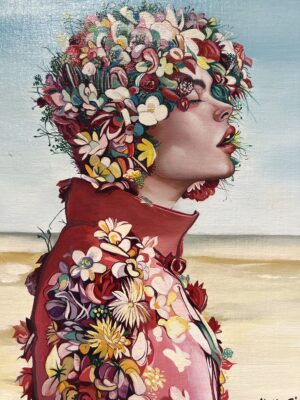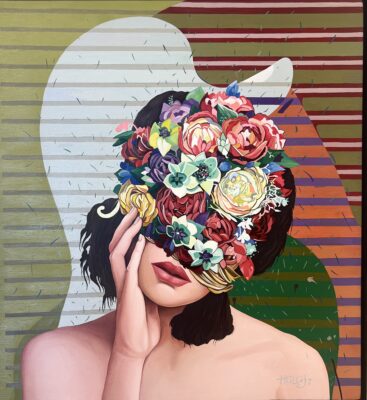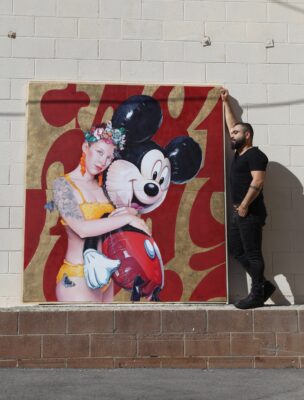Minds Are Flowers, I
oil on wood panel
20″x16″
INQUIRY
Minds Are Flowers, Couple
Oil on wood panel.
16×16 in.
INQUIRY
Mindset, 2024
Oil on wood panel.
14×11 in.
INQUIRY
Floral Portrait
oil on wood panel
12″x10″
INQUIRY
Floral Mind, 43
Oil on wood panel.
40×36 in.
INQUIRY
Floral Portrait
Oil on wood panel.
24×22 in.
INQUIRY
Floral Portrait
Oil on wood panel.
14×11 in.
INQUIRY
Floral Mind # 43
Oil wax textile mixed media on panel.
40×36-in.
INQUIRY
Floral Portrait
Oil on wood panel.
24×22 in.
INQUIRY
Blue Bird, 2017
Oil wax textile mixed media on panel.
54×46-in.
INQUIRY
Floral Mind, 2020
Oil on wood panel.
62×48 in.
INQUIRY
Butterfly, 2020
Oil Gold textile mixed media on wood panel.
62×48-in.
INQUIRY
Floral Mind, 2020
Oil Gold textile mixed media on wood panel.
62×48 in.
INQUIRY
Butterfly # 6, 2019
Oil mixed media on the panel.
46×40 inches.
INQUIRY
Floral Mind, 5, 2020
Oil mixed media on panel.
48×40 inches.
INQUIRY
Awards:
- 2012: City of Calabasas Art Contest 1st place winner
- 2011: Art Award by Antonio R. Villaraigosa, Mayor of Los Angeles, CA
Museum Donation:
- 2012: Donation of one work to Permanent Collection of Mark Rothko Museum, Daugavpils, Latvia
Collectors:
Collectors
- Pepsico Company Collection, Dubai, UAE.
- Princess Anita Of Hohenberg Collection, Vienna Austria.
- Victor Drai, Hollywood Entertainment Famous director, Las Vegas, NV.
- Joseph Reap, Collection of, Morgan Stanley Headquarters Manhattan, NYC.
- Nersesian Collection, New York, NYC.
- Timothy G. Smith, Collection West Hollywood, CA.
- Gary Goldstein Design Associates, Irvine, CA.
- Anthony J. Cale & Associates, London, UK.
- Lea Black Collection, Miami, FL.
- Alex Reid Collection, West Village, NY.
- Ryan O’Neal Collection, Golden Globe Nominated Actor, Malibu, CA.
- Deanne-Joel Fried Collection, Los Angeles, CA.
- Maia Neumann Collection, Nice, France.
- Jennifer Jonak Collection, Graswell, OR.
- Denis Sutro Collection, Carver Sutra Wine Company, Napa Valley, CA.
- Elizabeth Turner Ottosen Collection, Basel, Switzerland.
- Samira Barlava Collection, Beverly Hills, CA.
- Poor Hb Collection, London, UK.
- Philipe Caland Collection, Los Angeles, CA.
- Ryan Finley Collection, Portland, OR.
- Scott Bernstein Sony Music head quarters office, Beverly Hills, CA.
- Nishanta Baidya Collection.
Residency:
- 2016: International Art Symposium “Atelier An Der Donau,” Vienna, Austria
- 2014: International Art Symposium “Atelier An Der Donau,” Vienna, Austria
- 2012: Mark Rothko Artist In Residence, Daugavpils, Latvia
Minas Halaj
“ The Trouble with Flowers “
By Danna Lorch, Middle Eastern Studies from Harvard University.
Minas Halaj creates what he can’t have. In this case that is pure green space. If he returned to his native country of Armenia with its cerulean skies, twisting rivers and rugged mountain ranges, his brush would inevitably veer towards gritty cityscapes.
He works from a studio that straddles the border between Los Angeles and Hollywood. Dusty palm trees line an industrial block of warehouses. Pollution hovers over the Hollywood skyline, adding a dreamy haziness to the concrete jungle that mimics the opening scene from a classic film.
The portraits comprising Halaj’s ongoing Floral Minds series examine the inherent human longing to live in harmony with nature despite the competing pull of the modern, plugged in world. From political personalities to dewy fashion models, these are the people who stop to snap the selfie which pops up on your social media feed as you relax on your living room couch. These are the glamorous, self-titled “public figures” who materialize larger than life on all your devices and yet can also vanish in the blink of an eye with just one bored scroll of the thumb. Halaj is propelled by the belief that, “There is a unique flower inside each of us that grows and changes form and color. The flowers are in our veins and part of our anatomy. We are innately connected to nature, but there is a conflict within that pulls us towards the more complicated wider world.” Even though the details of their faces are camouflaged by ornate bouquets of wildflowers, the subjects here are still relatable. In a sense, each distinctive choice of flowers conveys a more intimate and vulnerable reading of a person than a conventional glimpse of the visage could offer. The majority of the Floral Minds works are numbered rather than titled. #1 is Halaj’s wife. Despite their obscured faces, several of the subjects are easily recognizable to those who keep up with American pop culture. #10 is clearly President Trump, his open mouth spouting blossoms rather than angry rhetoric.
The Bluebird (which does not have a corresponding number) is a vanitas, riffing off Medieval funerary art in which a skull and fresh flowers pointed to the inevitability of life ending in death and decay. The bluebird perched on the fresh faced subject’s forearm is so realistic it seems possible to glimpse its heart thundering through its shiny plumage. And yet, Halaj seems to be saying, even these young things are destined to age. What matters most is the present moment.
Buddhist teachings often speak of the lotus flower, a resilient pink bloom that grows in even the thickest of mud. The lotus is symbolic of an aspiration to reach spiritual purity despite earthly troubles. Halaj agrees with a sigh. “The flowers are a hint of paradise. As humans, we live in modern society but don’t realize that paradise is right here.”
Disturbingly, Floral Minds #39 depicts an infamous mass shooter.
How can a face so often associated with evil be obscured in exquisite flowers? Halaj painted the portrait as a kind of therapeutic act to try to make sense of the deadliest shooting in United States history. He says, “As a result of the gun regulations we have in the US, there are innocent children and adults getting killed. The flowers are squeezing the shooter’s neck. They are covering parts of his personality he doesn’t want the world to see.”
This alludes to the restrained violence at play just beneath the surface of Floral Minds. Halaj uses his hands to apply wet cement and viscid street tar to his canvases; background textures that are hard to fully appreciate on Instagram.
Perpetually influenced by fashion’s great ateliers and their fabled or fraught relationships with Hollywood celebrities, he trawls estate sales for valuable Victorian wedding gowns which he then nonchalantly shreds for collaging. There is an unresolved tension here between natural and manufactured forms of beauty, between a commitment to traditional portraiture and a medium-bending defiance, even between irrepressible evil and naive goodness.
Coming of age during Armenia’s war with Azerbaijan, Halaj grew up with an artist for a father, the painter Samuel Hallaj. He wasn’t allowed to touch anything in the generator-powered studio, but often loitered in the shadows stretching to follow the unspoken conversation his father’s paintbrush held with each canvas. Despite his father’s discouragement to take on an artist’s unpredictable lifestyle, Halaj started to create his own art, first selling a work on paper to a visiting European Union diplomat.
He then attended State Academy of Fine Arts in Yerevan to study classical portraiture, but soon left for the United States with just a little cash and a desire to break out on his own. With a BFA from the San Francisco Art Institute and a suitcase filled with paintbrushes, he moved to Los Angeles, and quickly became part of the city’s experimental art scene with shows coinciding with Art Basel Miami three years running and work from Floral Minds included in Faces in the Crowd, a 2016 group exhibition at Art Share L.A. Standing at his easel in Los Angeles Halaj admits, “It took many years to forget what I’d learned in classical painting and do things with my hands that broke all the rules.” However conceptual his practice might evolve, Halaj’s work will always betray hints of that journey.
In Floral Minds #34, a fashion model’s face is upturned towards the viewers, her mouth slightly ajar to show off perfect white teeth, her eyes replaced by a delicate tapestry of flora. This fragility is contradicted by the rough collage of raw edged paper strips Halaj has used to outfit the subject—a hint at the coarseness of industrial society. Although from a distance these portraits have a classical air, upon close inspection it becomes obvious that they are not entirely pretty. There is an unpredictable complexity to Floral Minds that makes it possible to discover something new each time the canvases are encountered.
















